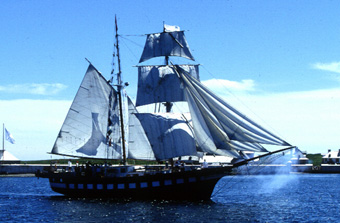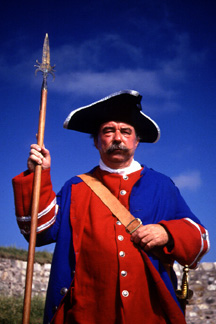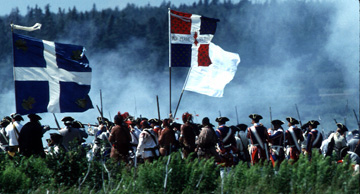
Behind Website Design and Content © by
Eric Krause, Krause House Info-Research Solutions
(© 1996)
All Images ©
Parks Canada Unless Otherwise Designated
Researching
the Fortress of Louisbourg National Historic Site of Canada
Recherche sur la Forteresse-de-Louisbourg Lieu historique national du Canada
Search All Sites/All Menus ~
Cherche Tous les Sites/Tous les Menus
Behind The Scenes Site

 Background:
Background:
For three full days last summer (July 28-30), the Fortress of Louisbourg National Historic Site came to life as never before. Close to 1200 historic reenactors from across Canada and the United States camped out at the reconstructed 18th-century town. Thirteen tall ships, including Bounty, Rose and Bluenose filled the harbour and long boats crowded the waterfront quai.
All came to celebrate an important colonial past. Some 250 years ago, Louisbourg was the cornerstone of France's northwestern Atlantic empire and a focus of imperial struggle in North America. Initially settled by the French in 1713, Louisbourg soon became a commercial, administrative and military centre. With a population of several thousand, Louisbourg was French North America's busiest port. Besieged and captured twice, the town declined in importance during the 1760s.
Today Louisbourg remains a picturesque fishing town and the site of North America's largest historic reconstruction - the Fortress of Louisbourg National Historic Site. Approximately one quarter of the historic town has been reconstructed. In addition to massive fortifications, over 65 buildings have been rebuilt ranging from humble outbuildings to the 360-foot long King's Bastion Barracks.
In 1995, Louisbourg celebrated three anniversaries. It was the 275th anniversary of the "official" founding of the French ville fortifiée, the 250th anniversary of the first siege and the 100th anniversary of the Sydney and Louisburg Railway. Major festivities occurred throughout the summer in both the modern and historic towns.
Select Photos: Encampment 1995
Photo Gallery~Galerie des photos:
Encampment 1995 / Rassemblement 1995
The spectacular highpoint was the Grand Encampment of July 28-30. Throughout the weekend, reenactors portrayed camp life and domestic skills as well as period military drill, ceremonies and tactics.
 Participants dressed to the half century between
Louisbourg's settlement and the end of the Seven Years War (1713-1763). Historical
accuracy of dress and comportment were important criteria for participation. The
reenactors stayed in period tents ranging from simple wedge tents to large, elaborate
marquis. Tent sites were located within the reconstructed town as well as outside the
walls.
Participants dressed to the half century between
Louisbourg's settlement and the end of the Seven Years War (1713-1763). Historical
accuracy of dress and comportment were important criteria for participation. The
reenactors stayed in period tents ranging from simple wedge tents to large, elaborate
marquis. Tent sites were located within the reconstructed town as well as outside the
walls.
The reenactors presented a variety of civilian and military interpretations. The compagnies franches de la Marine from St. Helen's Island (Montréal), the Tippecanoe Ancient Fife and Drum Corps from Indiana and the compagnies franches de Détroit were among the larger French units represented. British units included units of Fraser Highlanders from St. Helen's Island, Indiana and Halifax; equally impressive were grenadiers representing the 40th and 62nd Regts. and a large amalgamated unit of Rogers' Rangers from Québec, Ontario and New England. Reenactors portraying Native Americans were particularly popular with visitors. The Fortress' own garrison of compagnies franches and a newly-raised local volunteer militia also participated.
A spectacular demonstration of period military tactics featuring the Fortress artillery occurred daily. As many as 20,000 visitors watched these colourful and popular presentations over the three days.
 While most reenactment groups recreated military
units, some depicted civilians. These ranged from apothecaries to upper class dandies.
Civilian or military, all reenactors happily explained their costumes, camp life and
period skills such as fire starting with flint and steel and cooking. Demonstrations by
two dance troupes and by period musicians were highlights.
While most reenactment groups recreated military
units, some depicted civilians. These ranged from apothecaries to upper class dandies.
Civilian or military, all reenactors happily explained their costumes, camp life and
period skills such as fire starting with flint and steel and cooking. Demonstrations by
two dance troupes and by period musicians were highlights.
Tall ships and period longboats added a fitting maritime dimension to the commemoration. There was a breathtaking sailpast of tall ships on the opening day with salutes fired by ships and Fortress.
The Lieutenant Governor of Nova Scotia, the Honourable James Kinley, opened the encampment at a colourful ceremony. The Fortress of Louisbourg Volunteer Association presented reproduction colours of the original compagnies franches de la Marine to our modern Fortress garrison.
On Saturday July 29, the American General Society of Colonial Wars rededicated its memorials erected in 1895 and 1936. The ceremony included a grand parade of reenactors to the monuments on Rochefort Point, site of a major 18th-century burial ground.
The weekend event closed Sunday evening with the presentation to all participants, staff and volunteers of commemorative medals based on the Fortress foundation medal of 1720. Participants also received Parks Canada 50-hour Volunteer pins for their efforts. The closing included an historic meal and a period concert.
The event was wildly successful with attendance far exceeding expectations. The first day, there were reports of traffic backed up for 25 kilometers out of Louisbourg. Paid attendance totalled over 20,000 compared to just over 5,000 for the same weekend the year before.
The influx required hasty improvements to traffic control, extra buses to the site and speedier processing at the Visitor Centre. Enthusiastic accolades from media, participants, visitors, local residents and our very tired staff and volunteers far outweighed the few complaints.
As this was our first Grand Encampment, we had no way to determine the response from either participants or visitors. Initial speculation was that we would be lucky to receive 350 reenactors. Eventually nearly four times that number participated. The scale of the event presented many challenges as we had little previous experience. Our first event was a large one.
In December 1991, the Site formed an initial team consisting of Anne O'Neill, (Acting Head of Operations), Greg Joyce (Military Animation Supervisor) and myself (Curator of Furnishings). Planning continued over the next four years. In the final year the team increased to include representatives from all sections in the Site. Our team also coordinated with the Louisbourg 1995 Commemoration Society which oversaw celebratory events in the town.
Given our inexperience with events for reenactors, we sought expertise elsewhere. Team members attended the 1992 French and Indian War weekend at Old Fort Niagara. By happy circumstance, Niagara-on-the-Lake celebrated the Bicentennial of the Simcoe Landing that same weekend with Fort George National Historic Site being a major venue. Both events involved hundreds of 18th-century reenactors. Again in 1994, two team members attended events at Old Fort Niagara and at Québec. The first-hand experience was invaluable.
The staff at Old Fort Niagara, Fort George and Qu‚bec were extremely helpful and forthcoming with suggestions. Other Parks Canada staff shared their reenactment experience. Establishing such networks was critical. Historic sites place special constraints on such events and the advice of those who had gone before benefitted Louisbourg.
The event at Old Fort Niagara was most like our own both in its nature and in its historical time period. We foresaw that their participants would form a nucleus for those coming to Louisbourg. Their staff kindly supplied information as well as lists of reenactment units and contact people. A number of their staff eventually capped their involvement by coming to participate themselves.
Having a large animation program of our own, we needed to determine how reenactors would blend with it. In late July, 1992, we hosted a small Rogers' Rangers unit (approximately 20 people) from Québec. Even this small encampment underscored that a large one would be the site's interpretive focus for the weekend. Our own programs simply could not be run parallel and remain unaffected by it.
We quickly learned that a site needs to provide certain basics for reenactors. Obviously suitable campsites with designated firepits top the list. Water, wood, straw and washroom facilities are also required. In most instances, the latter will mean recourse to port-a-potties. Reenactors are used to these but appreciate cleanliness. At Louisbourg we received compliments for arranging cleaning twice a day.
Estimating the required amounts of supplies and services necessitates consultation with other sites and events. But expect the unexpected. At Louisbourg we upped the Old Fort Niagara's ratio of firepits and wood in respect to our sometimes cooler climate. An unusually hot weekend left us with extra firewood for our own animation program.
Each event develops its own rhythms and not all of them can be anticipated. We had carefully proportioned the firepits equally through the different camping areas, only to find the ones outside the walls underutilised. The unique opportunity to socialize around campfires in a reconstructed 18th-century town proved more appealing to reenactors than did the camps outside the walls.
Food was a major consideration. Many reenactment events provide at least some meals, particularly if alternatives are not at hand. During the Grand Encampment, it would be difficult to reach local restaurants. In consequence, we provided four breakfasts and two suppers over the weekend. Our on-site restaurants catered them but still at a cost to our event budget. The restaurants also provided takeout lunches at modest cost to the reenactors.
The above were only a portion of the full range of logistical services that had to be provided. It was as if the equivalent of the modern town of Louisbourg had moved to the site for the weekend. Health concerns alone ran from a childbirth to heat prostration and dehydration.
Reenactors love to share their interests with the public and it is that interaction which makes the events so successful and enjoyable. The host site has to provide suitable opportunities for that exchange, yet they must do so in consultation with the reenactors. It is sometimes easy to forget that the latter have their own needs for privacy and peace and quiet. Reenactors are on their vacations and are dedicated volunteers, not employees. They deserve to be treated as such - excessive scheduling can only backfire.
A site's motivations and those of the reenactor are not always the same. Tactical demonstrations are a case in point. Reenactors are looking for a safe, interesting and enjoyable event. The site also wants this, but for the public as well. The wants are not exclusive yet some degree of compromise may be necessary. At Louisbourg, the available demonstration field was relatively long and narrow. The tactical had to be carefully discussed and coordinated with the reenactors to ensure both safety and interest.
Given that this was our first event, communication with the reenactment community was a priority. Mailouts began a year and a half before the Grand Encampment and grew longer as the event approach. Even so, further elaboration was often required and Anne Marie Coutinho, our event clerk, was soon on a first-name basis with many participants.
Essential to our success was the fiscal and other support that we received from our regional and national office. Parks Canada's national Black Powder Supervisors (including Wayne Moug, Dave Webb and Bob Andrews) participated. In addition to monitoring the tactical demonstrations, they willingly pitched in where needed. André Gousse also served as Event Commander and Larry Ostola provided colour commentary for the tactical.
The Grand Encampment required much behind the scenes support. Numerous local volunteers, including our militia unit helped set-up camps, manned security lines and a multitude of other tasks. Site staff responded above and beyond the call of duty.
Complementing the Grand Encampment, Louisbourg hosted a sailpast of tall ships. Victor Suthren, Director General of the Canadian War Museum, organized the Great Lakes Flotilla which sailed from Kingston, Ont. via Montréal, Québec and Charlottetown. It was joined at Québec by the frigate, H.M.C.S. Terra Nova, which was to act as the official reviewing platform. In addition the War Museum sent a costumed ground information unit. Unlike the other tall ships, the Great Lakes Flotilla came prepared with costumed crews to participate in the Encampment.
Media interest in both the Grand Encampment and the tall ships was intense. In addition to local and regional television ,radio and print, there were crews from the National Film Board, Radio Canada, ATV and assorted independent videographers and photographers. All had to be coordinated and assisted and media relations was an important aspect of the weekend.
The Grand Encampment and associated Sailpast was an incredible success. The weather cooperated beautifully (who would have believed a weekend of sunny skies and hot temperatures?) At the time, the feelings of participants and visitors were all high. The reenactors, drawn from a larger area and broader time frame than usual, joked about it being "the Woodstock of Historical Reenactments". Our own staff felt it was an exhilarating event and one that really brought the site to life. The pristine state in which the reenactors left the site impressed all staff but the site seemed empty in spite of sunny skies and typically busy visitation.
Media coverage continued long after the event. Numerous newspaper and magazine features and at least two videos have been produced. One reprised an hour special broadcast regionally and later nationally in a half-hour format. The Radio Canada special has been shown nationally and internationally. We hope the publicity gained will influence our visitation for years to come. With luck, another Grand Encampment will then be in the works.
Select Photos: Encampment 1995
Photo Gallery~Galerie des photos: Encampment 1995 / Rassemblement 1995